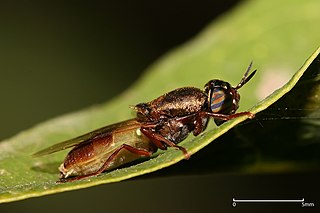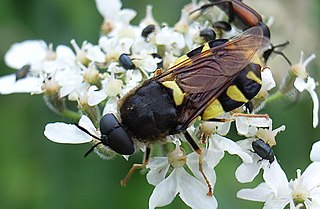
Odontomyia is a genus of soldier flies in the family Stratiomyidae.

Actina chalybea is a species of 'soldier flies' belonging to the family Stratiomyidae subfamily Beridinae.

Stratiomys is a genus of flies in the family Stratiomyidae.

Stratiomyini is a tribe of flies in the family Stratiomyidae.

Pachygaster is a genus of flies in the family Stratiomyidae.

Oxycera is a genus of flies in the family Stratiomyidae.

Chorisops is a genus of flies in the family Stratiomyidae.

Beris is a genus of flies in the family Stratiomyidae. They are small flies with reduced palpi. The scutellum has spines and the abdomen has seven visible segments. Their eyes are contiguous in the male.

Stratiomyinae is a subfamily of flies in the family Stratiomyidae.

Clitellariinae is a subfamily of flies in the family Stratiomyidae.

Pachygastrinae is a subfamily of flies in the family Stratiomyidae.

Cyphomyia is a genus of flies in the subfamily Clitellariinae.
Euparyphus is a genus of flies in the family Stratiomyidae.
Caloparyphus is a genus of flies in the family Stratiomyidae.
Euparyphus arizonae is a species of soldier fly in the family Stratiomyidae.
Ptilocera is a genus of flies in the family Stratiomyidae.
Lasiopa is a genus of flies in the family Stratiomyidae.
Cibotogaster is a genus of flies in the family Stratiomyidae.
Panacris is a genus of flies in the family Stratiomyidae.
Euparyphus patagius is a species of soldier fly in the family Stratiomyidae.










